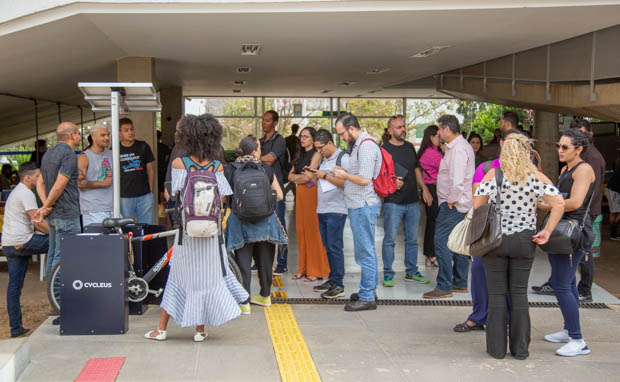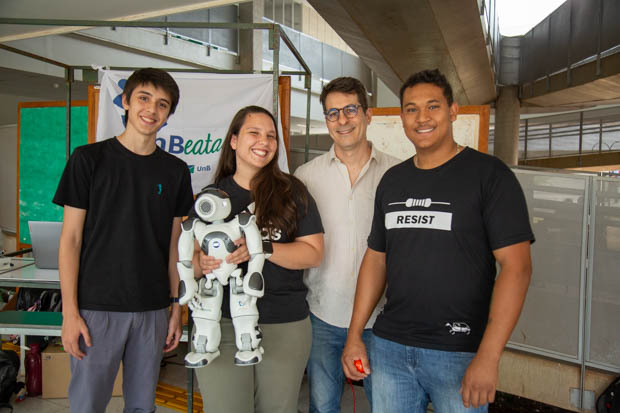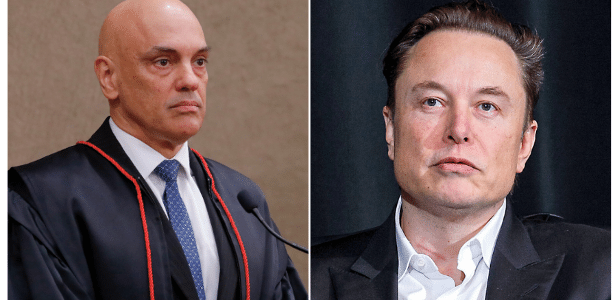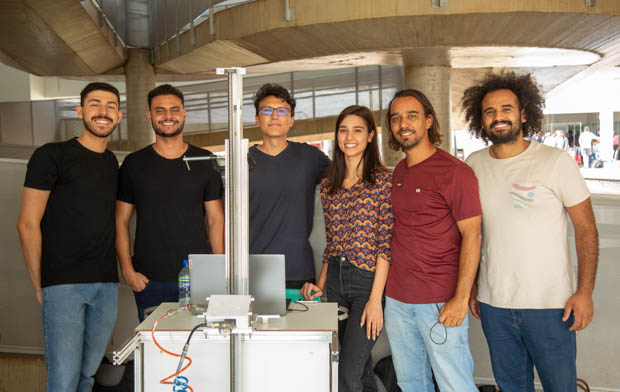Open to the community, the event at Faculdade UnB Gama presented engineering projects developed by students
Taking place on Wednesday (19), the Exhibition of Innovation and Technology (FIT) is an opportunity for students to present projects developed in the disciplines and research activities developed throughout the semester. All under the curious gaze of the community, invited to find out what is being done at the university.
Based in Faculdade UnB Gama (FGA), the FIT has been held since 2018 and is in its seventh edition this year. At the event, prototypes developed in the System Integrator Project II were shown, explained Alex Reis Professor of Energy Engineering, FIT Coordinator.
FGA is a campus of the University of Brasilia dedicated to undergraduate courses in various fields of engineering. For this very reason, visitors and fellow students and professors come across creative projects, with an emphasis on sustainability, practicality and efficiency. An example of this is the proposal uniting technology, the environment and the proper handling of toxic waste through a battery disposal machine.

Union National Bank does, community sees and participates – To facilitate the moment of painting the wall, the Android painter He determines in his system which area will receive the coloring, and with that the only work is to press a button. For software engineering student Yudi Yamane, it’s always interesting to introduce it to the public, to see people’s willingness to interact, and to understand how the prototype works.
“It is an exchange of experiences: the person learns a bit about how the project is done and the student also learns from the new point of view that the visitor offers,” he said. Youdi Yamani and 15 other colleagues spent four months developing the robot’s process, which could even be applied in the routines of people with mobility difficulties.
Gathering students from electronic courses, software engineering and energy, project MiAuFeeder It is an automatic pet feeding machine. With the support of an application, the user will be able to program the times of eating and the amount of food to be given to the pet.
João Victor Valadão, a software engineering student, said that re-educating pets was one of the points the team made to develop the project.
“Once the time has been set, the first motor releases the feed, which will drop into the tray below. There is a scale that measures the predetermined amount. Next, the second motor is activated, which empties the contents into the trough. Feed becomes available during the programmed time, and then, potential leftovers are collected in the tray, which will perform a new weighing process to determine whether the animal has eaten or not,” he explains.

Health and learning in a fun way – With the symbol of Brazil’s largest bird emblazoned on the branding, the project Empowerment, Mobility and Autonomy (EMA) In 2015 in partnership with engineering courses, physiotherapy and physical education. The group works with paraplegics and quadriplegics in the use of rehabilitation techniques.
This is the case of an conditioned tricycle that generates electrical stimulation so that patients with limb paralysis can perform pedal motions. Paralympic athlete Estevao Lopez has been involved in the project since the beginning. He says that by using the technology, he has noticed benefits in his body.
However, it was not so simple to start testing the technology. This is because Estevão thought it was impossible for you to pedal. “After a lot of insistence from a physical therapist, I decided to give it a try and say it was love at first bump. After stimulating my muscles for the first time, I never stopped,” he says.
project coordinator EMARoberto Baptista, professor of electrical engineering, is also responsible for the other prototypes shown at FIT. One of them is played by the team Unbeatablefrom the English term unbeatable: with a robot no, and participate in Android football competitions. In addition, the invention is being taken to schools to teach robotics interactively to younger students.

“It is an opportunity we have to study robotics itself, technology, computer vision and the field of artificial intelligence (AI). Based on this knowledge, we were able to create something that we apply in our daily lives,” said electronic engineering student Fernanda Diniz, who participated in the project.
According to Professor Roberto Baptista, the main thing is that students gain experience working with very complex equipment. Highlights “This project is essential for students to implement what they learned in the classroom, in an advanced robotic platform.”
* Journalist trainee at Secom/UnB.

“Hardcore beer fanatic. Falls down a lot. Professional coffee fan. Music ninja.”


:strip_icc()/s02.video.glbimg.com/x720/12553381.jpg)

:strip_icc()/i.s3.glbimg.com/v1/AUTH_fde5cd494fb04473a83fa5fd57ad4542/internal_photos/bs/2024/g/0/V5FYuBQliYVGYOkMB4Aw/thumbnail-amanda.jpg)

More Stories
Brazilian scientist wins disputed Marie Curie research grant | Sciences
The European Space Agency's probe detects “spiders” on Mars Sciences
UFRJ is Africa's Ambassador for Science – Conexão UFRJ